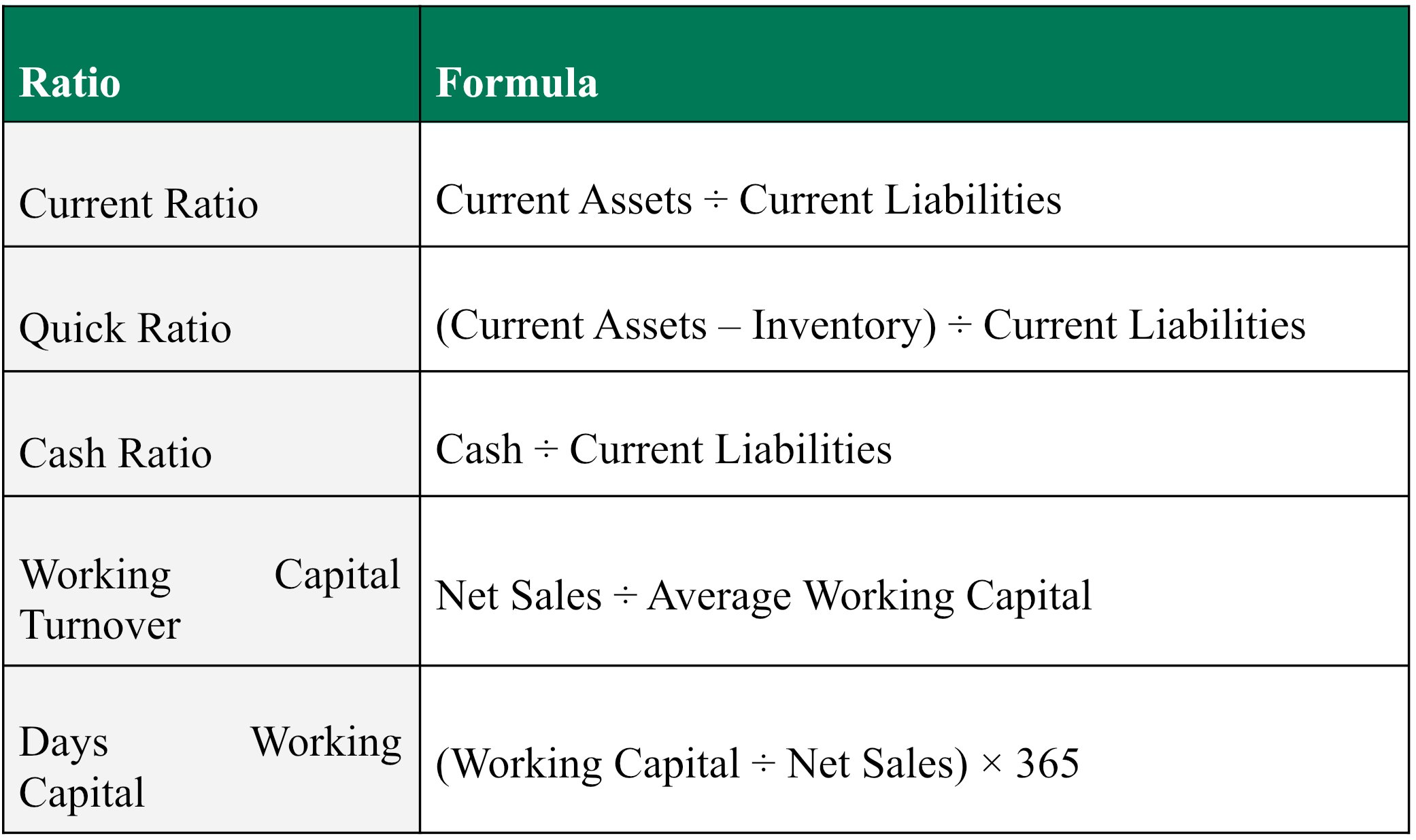How to use working capital ratios for financial analysis
You might feel like your business is doing well. Profits are steady, and invoices are paid. But what happens if revenue dips next month? Can your business still manage wages, vendor payments, and routine costs?
That’s where working capital ratios come in. As a key part of financial analysis, they reveal how much short-term flexibility your business truly has, something a profit-and-loss statement alone can’t show. If you’re wondering how to calculate net working capital, we’ve got you covered.

Understanding Working Capital Ratios
Working capital measures what a company has available after covering short-term obligations. So, what is that number? There, the ratios step in. They help you determine the extent to which your business is prepared to meet its short-term requirements, such as rent, payroll, or unexpected debts. These include:

They provide opposite lenses. Working in combination, these working capital ratios help you strengthen your financial analysis by a better understanding of your liquidity, inventory turnover, and capital effectiveness.
Key Working Capital Ratios and How to Calculate Them
When you understand what each ratio suggests, it will be easier to raise red flags, make sound decisions, and study the financial situation of a business. These are two examples:
Example 1: Retail Business
A clothing store has current assets of £195,000, inventory of £72,000, and liabilities of £90,000. The current ratio is 2.17. The quick ratio falls to 1.37 without inventory, highlighting limited liquidity without product sales.
Example 2: Cloud-based Business
A cloud-based startup with current assets of £285,000, minimal inventory, and liabilities of £95,000 has both a current and quick ratio of 3.0, indicating a strong cash cushion.
That is because these insights can either lead to stable growth or result in a cash crunch.
Interpreting Working Capital Ratios

Ratios become meaningful in context. What’s “healthy” depends on your industry, company size, and operations.

Amazon, for instance, has a low current ratio due to fast turnover and flexible supplier terms, unlike a manufacturer with slower cycles.
Deeper Ratio Insights
Certain ratios appear with greater precision. The quick ratio does not consider inventory and emphasises cash and receivables, which is critical when invoices become uncollected. The quick ratio and current ratio appear roughly the same in a SaaS business, as retailers are spread further apart.
The working capital turnover ratio brings out efficiency. A low number indicates that funds are tied up in stock or receivables, and a high number indicates lean operations with minimal protection. Frequent analysis of working capital facilitates the early detection of threats, as exemplified by a decline in the current ratio from 2.5 to 1.8.
Applying Ratios to Business Decisions
Working capital ratios inform daily business choices. Here’s how companies apply them:
Managing Cash Flow: A quick ratio below 1.0 suggests speeding up collections. A consulting firm might shorten payment terms or offer early payment discounts.
Inventory Strategy: There is a lot of stock when the turnover is low. Reevaluate reorder points or forecasts to reduce storage costs or obsolescence.
Vendor and Customer Terms: As receivables start increasing at a keener pace than payables, there are weaker cash flows. Strike favourable terms or modify customer credit policies.
Financing and Growth: Strong ratios signal discipline, appealing to lenders and investors. They also guide when to expand or pause plans.
Managing a growing business? Stay on top of working capital with Cash Flow Frog, built for small businesses→
Tools and Best Practices for Analysis
Manual tracking works early on, but larger businesses benefit from dedicated tools:
Cash Flow Frog: Helps monitor liquidity and plan ahead.
QuickBooks: Suits businesses that use it for accounting
Excel/Google Sheets: Flexible but time-consuming
Float: Simple forecasting for smaller teams
Still, tools alone aren't enough. To make working capital analysis effective, data must be reviewed regularly and used proactively.
Best practices include:
Monthly reviews
Seasonal comparisons
Setting internal targets
Insights should guide action, not sit in a report
Need a clearer view of your working capital? Be proactive using Cash Flow Frog’s forecasting tools →
Putting Ratios into Action
Working capital analysis draws a keener insight into the financial picture of businesses. These ratios assist in making wiser decisions, either in releasing a product, adapting to changes in the market, or scheduling the next quarter.
Have you applied working capital ratios in your company? We’d love to hear how they’ve helped.
Explore Belgravia this Christmas with a festive pub crawl through London’s most charming historic pubs, from The Grenadier’s cosy mews hideaway to The Nags Head’s quirky classic tavern…
From the joys of Christmas at Kew to the lively Smithfield meat auction, and from major concerts and ballets to intimate workshops and family-friendly trails, the city offers an extraordinary mix of experiences. This guide brings together the very best of Christmas in London…
This guide highlights some of the must-see art exhibitions to visit over the festive period in London, including the days between Christmas and New Year’s. From major retrospectives of international masters such as Kerry James Marshall, Wayne Thiebaud, and Anna Ancher, to engaging contemporary works by Danielle Brathwaite-Shirley, Jennie Baptiste, and Tanoa Sasraku…
London’s cultural scene, a gallery or museum membership is the perfect alternative to another pair of socks. From unlimited access to exhibitions and exclusive events to discounts in shops and cafés, these memberships offer experiences that can be enjoyed throughout the year, while also supporting the vital work of arts organisations…
Your guide to London’s can’t-miss events this week, 17–23 November 2025, from Cabaret Voltaire live at ICA to Ballet Shoes at the National Theatre and The Evolution of UK Jazz at the Barbican…
Charlotte Winifred Guérard is a London-based artist and recent graduate of the Royal Academy of Arts School, where she was recognised as a Paul Smith’s Foundation scholar for her artistic achievement. Her work has been exhibited at the Royal Academy, Coleman Project Space, Fitzrovia Gallery, Messums and Palmer Gallery, and she has completed prestigious residencies including…
This week in London, you can enjoy festive ice skating, Christmas lights, jazz and classical concerts, and a range of art exhibitions. Highlights include Skate at Somerset House, Christmas at Kew, the EFG Jazz Festival, and the Taylor Wessing Photo Portrait Prize 2025…
From the 6th to the 9th of November, the leading West African art fair Art X Lagos celebrates its 10th birthday at the Federal Palace on Victoria Island. Founded by Tokini Peterside-Schwebig in 2016, the fair has become an unmissable event in the global art calendar, attracting galleries from over 70 countries and participants from 170 countries since its launch…
If you’re after something bold, queer and completely uncategorisable this November, you need to know about KUNSTY, the Southbank Centre’s brand new four day performance series running from 5-8 November 2025…
London’s most beloved Christmas activity is back. As festive cheer returns to the city, with twinkling lights and the scent of mulled wine drifting through the air, for many Londoners and visitors from further afield, nothing quite captures the spirit of the city at Christmas like strapping on a pair of skates and stepping onto the ice…
As the crisp autumn air settles over London, the iconic gardens of Berkeley Square are once again hosting one of the most anticipated gatherings in the art and antiques world: the LAPADA Fair 2025, running from 28 October to 2 November…
November is a lively time to be in London, with the festive season in full swing and the city buzzing with events. From skating at Somerset House to Christmas lights switch-ons and festive markets like the Southbank Centre Winter Market, there are plenty of ways to embrace the holiday spirit. Beyond the seasonal festivities, London’s cultural calendar is brimming with art, music, and performance…
As far as weekend getaways go, this 70-acre estate offers a peaceful country escape with all the best elements of a traditional hotel experience. Staffordshire, arguably, is not yet on the map for luxury and leisure but set in the heart of the beautiful Staffordshire Moorlands, The Tawny surely is a beacon of things to come…
Art Basel Paris returns to the Grand Palais for its second edition from 24–26 October 2025, bringing together 206 leading galleries from 41 countries and territories. Below is our guide to seven artists not to miss at this year’s edition, each presenting distinctive work through their galleries…
Art Basel Paris 2025’s Public Programme turns the city into a stage for contemporary art, placing bold, large-scale works in streets, courtyards, and cultural landmarks - all free to visit. From a dreamy opera of 30 surreal figures at Palais d’Iéna to a colossal Kermit the Frog balloon looming over Place Vendôme, here is our guide to five standout works from the Art Basel Public Programme that you simply cannot miss…
Frieze London 2025 returns to Regent’s Park with a dynamic mix of emerging and established galleries, reaffirming the city’s creative pulse. Highlights include Esther Schipper’s dreamlike works by Sarah Buckner, Gagosian’s vibrant installation by Lauren Halsey, and Pace’s meditative paintings by William Monk. From Do Ho Suh’s ethereal fabric architectures at Lehmann Maupin…
Paris launches into its own spectacular celebration of art each October, transforming the city into a hub for collectors, curators, and cultural enthusiasts. From the grandeur of Art Basel Paris at the newly renovated Grand Palais to the focused energy of Paris Internationale, OFFSCREEN, AKAA and Menart, each fair contributes something unique to the city’s vibrant art scene.
British Ceramics Biennial is back and better than ever. Running until 19 October 2025, the dynamic programme of free exhibitions, screenings, talks and events is proving a hit with both locals and critics…and just an hour and a half’s train away from London, it’s well worth a day trip…
Echoes of Migration is the flagship summit to launch new not-for-profit platform Art Voyage this autumn. Echoes of Migration officially inaugurates Art Voyage’s innovative, itinerant cultural programme…and gears us up for what is in store for the Art Voyage Biennial….
Betty Ogundipe (b. 2001) is a multidisciplinary artist of Nigerian heritage whose work explores resilience, femininity, and the power of love and resistance. Her debut solo exhibition, LOVE/FIGHT at Tache Gallery…
The V&A’s Marie Antoinette Style, sponsored by Manolo Blahnik, is being hailed as the first landmark exhibition in the UK devoted to France’s most infamous Queen of Fashion. It is a glittering journey through silk, flamboyance and legacy….
Malta is fast becoming one of the Mediterranean’s hottest destinations, offering sun-soaked beaches into October, a thriving arts and culture scene, and stunning architecture and landscapes…
This October in London offers everything from Frieze and the BFI Film Festival to Peggy Gou, the London Literature Festival, and Halloween at Kew.
Discover the best restaurants in Malta, where to eat, drink and enjoy authentic Maltese food and Michelin-star dining…
From The Phoenicia Hotel and Iniala Harbour House, Valletta showcases some of Malta’s finest hotels, ranging from landmark luxury where royalty once danced to boutique hideaways filled with Maltese art…
October is the month for art in London, thanks to Frieze and several other art fairs taking place across the city. There will be a significant programme of shows across the capital’s galleries and institutions. Notable openings include Cosima von Bonin’s Upstairs Downstairs at Raven Row, examining 35 years of work through objects, characters, and early pieces unseen for more than a decade; Wolfgang Tillmans’ Build From Here at Maureen Paley, and Arthur Jafa’s first exhibition at Sadie Coles HQ…
This week in London, explore modern and contemporary art at the British Art Fair, experience couture drama with LACRIMA at the Barbican, celebrate heritage at the Chelsea History Festival, enjoy a decade of dance with Acosta Danza at Sadler’s Wells, and step into Shakespeare’s world with Hamlet at the National Theatre…
With just 100 days to go until Christmas, London’s West End is preparing for the festive season. Carnaby Street and Covent Garden have confirmed their 2025 Christmas lights switch-on dates, signalling the start of celebrations across the capital…
Ladbroke Hall has been a fixture in Notting Hill since 1903, when it opened as the Clément-Talbot car showroom, Britain’s first purpose-built car factory. Designed to resemble an English country house, the building has since served a variety of roles, from producing military vehicles during the First World War to housing Thames Television in the 1980…
















































